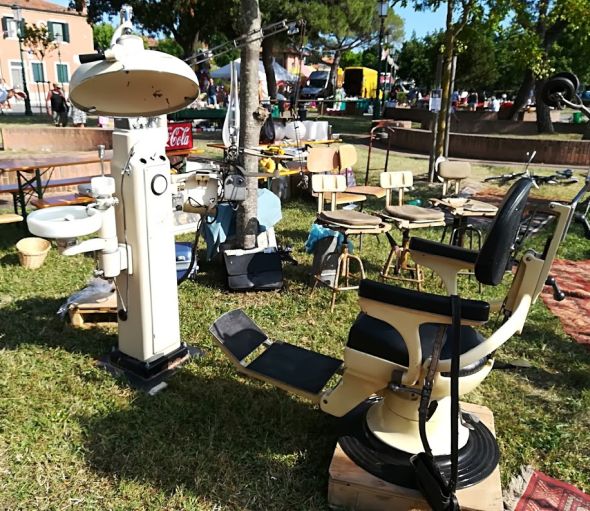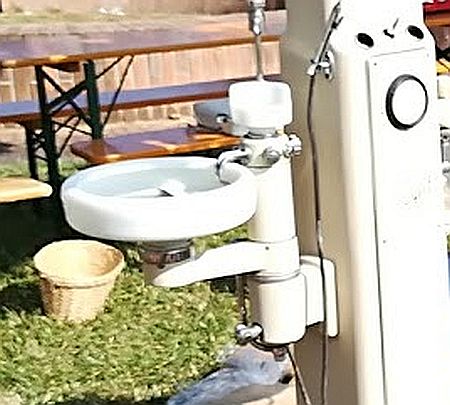Last Sunday the people of Malamocco celebrated the annual festa of the Madonna di Marina. Like a few other festivals — the one at Pellestrina on the first Sunday of August comes to mind — it is based on a legend involving a miraculous apparition of the Madonna. I’ll get to that in a moment.
What is reliably involved each year at Malamocco is a small sale of old and often eccentric stuff. I would say “antiques,” but that might be glamorizing them too much.
So forget the glamour, and while you’re waiting in line to pick up your plate of spaghetti alla malamocchina (with tiny clams called bevarasse), feast your eyes and your memory on this item. Anybody under the age of 50 probably has no recollection of it, but for the rest of us, I’m betting it still can bring on the shudders.


Speaking of Malamocco, you might want to know that the name is derived from Metamauco, by way of Medoacus, the Roman name of the Brenta River, which emptied into the Adriatic here. Could be useful on a crossword puzzle sometime?
It was originally a small settlement of families who cultivated vegetables, fished, and worked in the salt pans. The population grew in 452 A.D. with the fleeing dwellers from the lagoon shoreline seeking refuge from Attila’s Rome-bound hordes. It became the seat of the Venetian government between 742 and 811. In that year the new doge, Agnello Partecipazio, moved what was becoming Venice to the Rialto area and Malamocco returned to its earlier dimensions.
As for the Madonna di Marina herself, a legend springing from around the year 1300 tells of a certain Felice Dario, native of Malamocco, who found an enormous stump of wood lying on the beach and took it home to chop it up as firewood. (To give a more precise idea of this object, it’s called a ceppo [CHEH-po] in Italian, and while you certainly can burn it, it is more typically used as that heavy block on which you chop wood, or on which a butcher cuts meat, or on which a blacksmith places his anvil, or on which the public executioner places his customer’s head, etc.) In Venetian, the word is zoco (SOH-koh).
The ceppo disappeared three times, and three times Signor Dario found it back in its original place on the beach, at which point the Virgin appeared to him. The story ends there, though I suppose we could risk imagining miraculous cures and victories at sea and and platoons of male children and other beautiful things as a result. For the first years — no idea how many — the miracle was attributed to the “Madonna del zoco,” the “Madonna of the stump of wood used for chopping things on.” Somebody clearly thought that didn’t have the right ring to it, but I disagree.
I would tell you more about the festa, but the real point of this post isn’t the regata, or the procession, or the band, or even the (excuse me) Madonna and her chopping block. It’s the dentist’s chair. If I’d anywhere to put it, I’d have bought it and sat in it and rinsed my mouth and laughed triumphantly all day at the ghosts of all those dentists I’ve worn out.

5 Comments
Oh yes, I remember that sort of chair all right ?
That sounds a fun festival!
So is Metamauco the original name of the Brenta, or Medoacus?
I always wondered at the car ferry called Metamauco.
Medoacus was the Roman name for the Brenta River. It then evolved into Metamauco, and finally into Malamocco. Mystery solved!
Thanks! ?
I remember those dentist chairs from dental visits in the 60’s. As a child you needed to dislocate your neck so the dentist could get access and my particular dentist reminded me of Himmler- moustach & glasses, and the way he said ” get a grip” as he drilled to the bone. A surfeit of WW2 movies shown in the 60’s contributed to my impressions. Not a pleasant reminder but I will forgive you if you give a Lino reminisce soon.
Your delightful post brought back memories of sitting in the dentist’s chair in the 1950s. My mother worked, so we always visited the dentist in the evening, when the local radio station was, believe it or not, playing a tape of people saying the rosary–not a particularly comforting backdrop to drilling. The fact that years later, when I moved to D.C., my first dentist looked in my mouth and said “WHO did your teeth” didn’t make me feel any better. The silver lining: My Catholic friends are always impressed that this Methodist knows the rosary by heart!